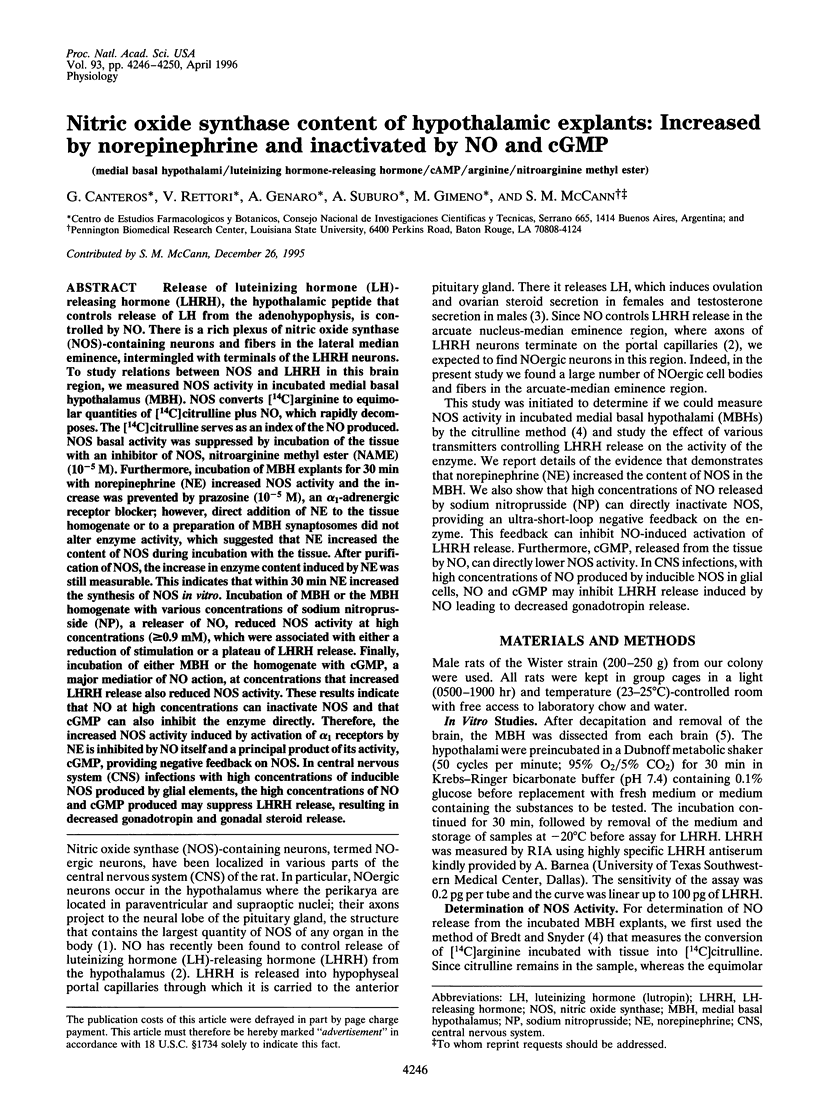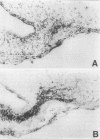Abstract
Release of luteinizing hormone (LH)-releasing hormone (LHRH), the hypothalamic peptide that controls release of LH from the adenohypophysis, is controlled by NO. There is a rich plexus of nitric oxide synthase (NOS)-containing neurons and fibers in the lateral median eminence, intermingled with terminals of the LHRH neurons. To study relations between NOS and LHRH in this brain region, we measured NOS activity in incubated medial basal hypothalamus (MBH). NOS converts [14C]arginine to equimolar quantities of [14C]citrulline plus NO, which rapidly decomposes. The [14C]citrulline serves as an index of the NO produced. NOS basal activity was suppressed by incubation of the tissue with an inhibitor of NOS, nitroarginine methyl ester (NAME) (10(-5) M). Furthermore, incubation of MBH explants for 30 min with norepinephrine (NE) increased NOS activity and the increase was prevented by prazosine (10(-5) M), an alpha 1-adrenergic receptor blocker; however, direct addition of NE to the tissue homogenate or to a preparation of MBH synaptosomes did not alter enzyme activity, which suggested that NE increased the content of NOS during incubation with the tissue. After purification of NOS, the increase in enzyme content induced by NE was still measurable. This indicates that within 30 min NE increased the synthesis of NOS in vitro. Incubation of MBH or the MBH homogenate with various concentrations of sodium nitroprusside (NP), a releaser of NO, reduced NOS activity at high concentrations (> or = 0.9 mM), which were associated with either a reduction of stimulation or a plateau of LHRH release. Finally, incubation of either MBH or the homogenate with cGMP, a major mediatior of NO action, at concentrations that increased LHRH release also reduced NOS activity. These results indicate that NO at high concentrations can inactivate NOS and that cGMP can also inhibit the enzyme directly. Therefore, the increased NOS activity induced by activation of alpha 1 receptors by NE is inhibited by NO itself and a principal product of its activity, cGMP, providing negative feedback on NOS. In central nervous system (CNS) infections with high concentrations of inducible NOS produced by glial elements, the high concentrations of NO and cGMP produced may suppress LHRH release, resulting in decreased gonadotropin and gonadal steroid release.
Full text
PDF




Images in this article
Selected References
These references are in PubMed. This may not be the complete list of references from this article.
- Bredt D. S., Hwang P. M., Snyder S. H. Localization of nitric oxide synthase indicating a neural role for nitric oxide. Nature. 1990 Oct 25;347(6295):768–770. doi: 10.1038/347768a0. [DOI] [PubMed] [Google Scholar]
- Bredt D. S., Snyder S. H. Isolation of nitric oxide synthetase, a calmodulin-requiring enzyme. Proc Natl Acad Sci U S A. 1990 Jan;87(2):682–685. doi: 10.1073/pnas.87.2.682. [DOI] [PMC free article] [PubMed] [Google Scholar]
- Bredt D. S., Snyder S. H. Nitric oxide mediates glutamate-linked enhancement of cGMP levels in the cerebellum. Proc Natl Acad Sci U S A. 1989 Nov;86(22):9030–9033. doi: 10.1073/pnas.86.22.9030. [DOI] [PMC free article] [PubMed] [Google Scholar]
- Canteros G., Rettori V., Franchi A., Genaro A., Cebral E., Faletti A., Gimeno M., McCann S. M. Ethanol inhibits luteinizing hormone-releasing hormone (LHRH) secretion by blocking the response of LHRH neuronal terminals to nitric oxide. Proc Natl Acad Sci U S A. 1995 Apr 11;92(8):3416–3420. doi: 10.1073/pnas.92.8.3416. [DOI] [PMC free article] [PubMed] [Google Scholar]
- Knowles R. G., Palacios M., Palmer R. M., Moncada S. Formation of nitric oxide from L-arginine in the central nervous system: a transduction mechanism for stimulation of the soluble guanylate cyclase. Proc Natl Acad Sci U S A. 1989 Jul;86(13):5159–5162. doi: 10.1073/pnas.86.13.5159. [DOI] [PMC free article] [PubMed] [Google Scholar]
- Mani S. K., Allen J. M., Rettori V., McCann S. M., O'Malley B. W., Clark J. H. Nitric oxide mediates sexual behavior in female rats. Proc Natl Acad Sci U S A. 1994 Jul 5;91(14):6468–6472. doi: 10.1073/pnas.91.14.6468. [DOI] [PMC free article] [PubMed] [Google Scholar]
- McCann S. M. Physiology and pharmacology of LHRH and somatostatin. Annu Rev Pharmacol Toxicol. 1982;22:491–515. doi: 10.1146/annurev.pa.22.040182.002423. [DOI] [PubMed] [Google Scholar]
- Rettori V., Belova N., Dees W. L., Nyberg C. L., Gimeno M., McCann S. M. Role of nitric oxide in the control of luteinizing hormone-releasing hormone release in vivo and in vitro. Proc Natl Acad Sci U S A. 1993 Nov 1;90(21):10130–10134. doi: 10.1073/pnas.90.21.10130. [DOI] [PMC free article] [PubMed] [Google Scholar]
- Seilicovich A., Duvilanski B. H., Pisera D., Theas S., Gimeno M., Rettori V., McCann S. M. Nitric oxide inhibits hypothalamic luteinizing hormone-releasing hormone release by releasing gamma-aminobutyric acid. Proc Natl Acad Sci U S A. 1995 Apr 11;92(8):3421–3424. doi: 10.1073/pnas.92.8.3421. [DOI] [PMC free article] [PubMed] [Google Scholar]
- Seilicovich A., Lasaga M., Befumo M., Duvilanski B. H., del Carmen Diaz M., Rettori V., McCann S. M. Nitric oxide inhibits the release of norepinephrine and dopamine from the medial basal hypothalamus of the rat. Proc Natl Acad Sci U S A. 1995 Nov 21;92(24):11299–11302. doi: 10.1073/pnas.92.24.11299. [DOI] [PMC free article] [PubMed] [Google Scholar]
- Shu S. Y., Ju G., Fan L. Z. The glucose oxidase-DAB-nickel method in peroxidase histochemistry of the nervous system. Neurosci Lett. 1988 Feb 29;85(2):169–171. doi: 10.1016/0304-3940(88)90346-1. [DOI] [PubMed] [Google Scholar]
- Snyder S. H., Bredt D. S. Nitric oxide as a neuronal messenger. Trends Pharmacol Sci. 1991 Apr;12(4):125–128. doi: 10.1016/0165-6147(91)90526-x. [DOI] [PubMed] [Google Scholar]
- Springall D. R., Riveros-Moreno V., Buttery L., Suburo A., Bishop A. E., Merrett M., Moncada S., Polak J. M. Immunological detection of nitric oxide synthase(s) in human tissues using heterologous antibodies suggesting different isoforms. Histochemistry. 1992 Nov;98(4):259–266. doi: 10.1007/BF00271040. [DOI] [PubMed] [Google Scholar]
- Suburo A. M., Rodrigo J., Rossi M. L., Martínez-Murillo R., Terenghi G., Maeda N., Mikoshiba K., Polak J. M. Immunohistochemical localization of the inositol 1,4,5-trisphosphate receptor in the human nervous system. Brain Res. 1993 Jan 22;601(1-2):193–202. doi: 10.1016/0006-8993(93)91710-a. [DOI] [PubMed] [Google Scholar]



